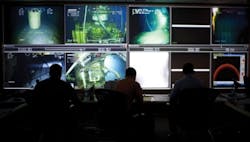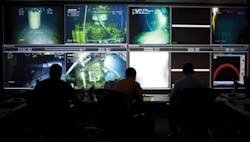An integrity test on the deepwater Macondo well in the Gulf of Mexico continued for several days as operator BP PLC and federal officials evaluated whether pressure readings might indicate reservoir depletion.
The first relief well, being drilled by the Development Driller III, reached a casing point at 17,862 ft total depth.
"We're 4 ft horizontally from the Macondo well at 2.8°, and we're looking directly at the Macondo well. So we're absolutely perfectly positioned," Kent Wells, senior vice-president of BP exploration and production, told reporters.
Crews were opening the hole by drilling it to a slightly bigger diameter on July 20. Weather delayed plans to run casing and cement on July 21-22.
"There's some testing to do followed by the drill out and ranging runs," Wells said. He estimates the relief well could intersect the Macondo well around the end of July.
Previously, Wells said it could take weeks to inject heavy drilling fluid into the bottom of the well to kill the flow of oil and gas and then to place a cement plug. He estimates the relief well will be completed in the first half of August.
Drilling of a second relief well, which started May 16, was paused at 15,874 ft measured depth so as not to interfere with the ranging runs being performed by the first relief well.
Well integrity testing
National Incident Commander and retired US Coast Guard Adm. Thad Allen authorized numerous 24-hr extensions of the well integrity test, which initially was planned for a 48-hr period. Extensive monitoring of the well and surrounding area included pressure readings, temperature readings, sonar tests, and seismic surveys.
The well integrity test started on July 15 after BP closed a three-ram capping stack, shutting in the well. On July 19, BP reported a pressure reading of 6,811 psi inside the top of the Macondo.
The start of the integrity test marked the first time since April that no oil and gas had leaked. An Apr. 20 explosion and fire on Transocean Ltd.'s Deepwater Horizon semisubmersible killed 11 crew members and resulted in a massive oil spill.
Scientists had expected a higher pressure reading during the integrity test. Allen said depletion might account for a reading below 7,500 psi.
Allen said test results will determine whether to return to using the oil and gas collection systems. The integrity test delayed some installation of additional containment capacity to increase recoverable oil volumes to 60,000-80,000 b/d.
BP has said these additional systems also will enable vessels to disconnect and reconnect faster in case a hurricane reaches the gulf.
Collection systems involving the Helix Q4000 multiservice vessel and the Helix Producer floating production unit were suspended for the test.
"At any moment, we have the ability to return to the safe containment of the oil on the surface until the time the relief well is completed and the well is permanently killed," Allen noted.
During the integrity test, BP closely monitored five leaks near the wellhead, Allen said on July 20, adding, "We've found nothing that would be consequential toward the integrity of the wellhead to date."
Allen said one methane seep was observed 3 km from the well, but it was believed to be coming from another well rather than Macondo. He did not elaborate.
Other small seeps briefly were observed in the range of 80-200 m of the wellhead on July 18.
"There is some natural seepage out there of both oil and gas," Allen said. He reported "anomalies" including gas bubbles around the sealing cap and also formation of gas hydrates caused by a leak in a metal gasket in a flange.
A federal science team is discussing if it can refine its earlier flow rate estimate of 35,000-60,000 b/d. Allen said the question is whether scientists can use pressure and temperature readings taken during the integrity test to more accurately calculate the flow rate. The alternative would be for BP to reopen the well and resume collecting oil and gas in surface vessels so all the flow could be measured.
An accurate flow rate estimate is needed to help federal officials calculate possible oil spill fines and penalties against BP if the company is found negligent.
'Static kill' considered
Engineers and scientists also are studying the possibility of using a "static kill" from the top of the well in addition to using the relief wells to kill from the bottom of the well. The static kill idea is "still very much in the design and planning phase," Wells said.
A failed "top kill" that BP attempted in late May involved turning around the flow direction of choke and kill lines on the failed Deepwater Horizon blowout preventer. Wells said the proposed static kill also would involve pumping heavy drilling mud at the top of the well through choke and kill lines.
"Now, the difference here is because the well is not continuing to flow, we don't need to pump at high rates and pressures," Wells said. "In fact we could go at very low rates and just marginally above the pressure. We could, at least initially, go quite slow. Eventually as we've got more mud into the well, it will start pushing back on the well and actually killing the well."
Wells called the static kill "a very different procedure than the top kill." At OGJ presstime, the federal science team and industry experts evaluated the risks of a static kill.
The static kill along with the relief well could accelerate the process of killing the flow of oil and gas. The relief well involves sealing the bottom of the well, and the static kill operation could do the same from the top.
"You can see how working in tandem, these two would have the ability to have the well completely killed in less time," Wells said. "It's clearly worthy of us going through all the analyses."
More Oil & Gas Journal Current Issue Articles
More Oil & Gas Journal Archives Issue Articles
View Oil and Gas Articles on PennEnergy.com



